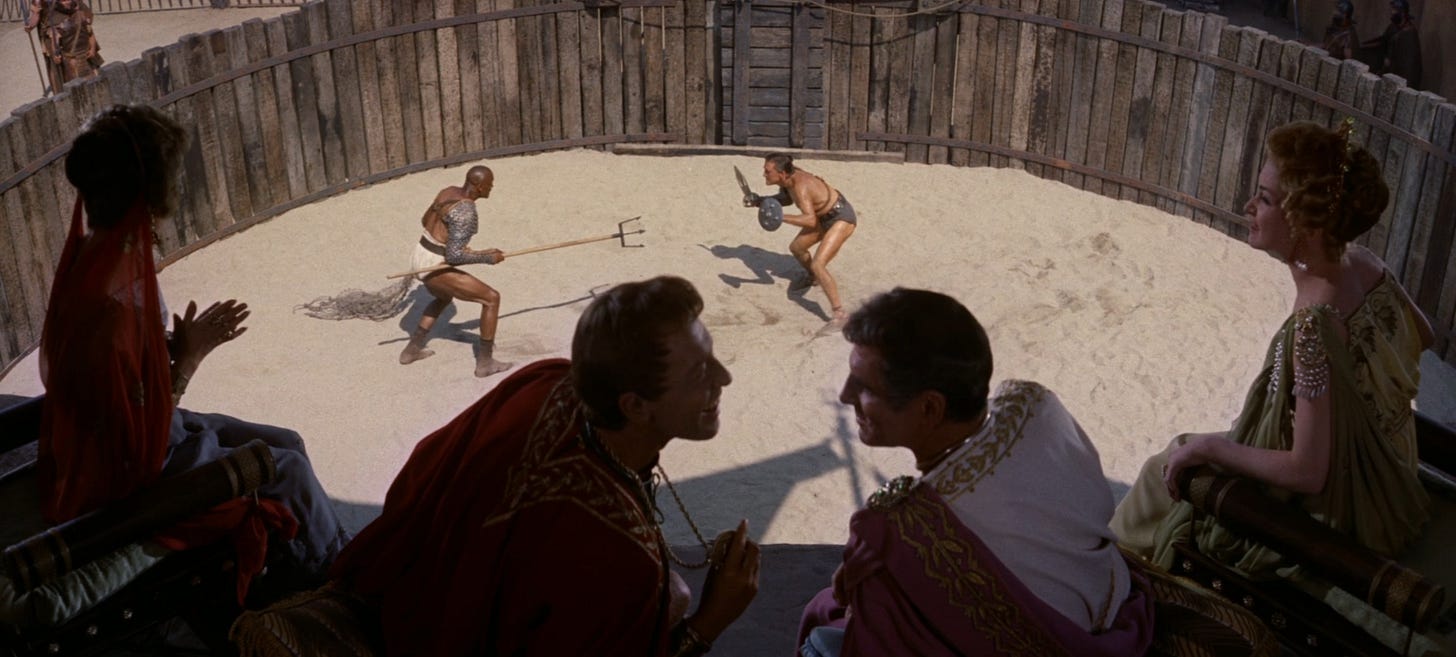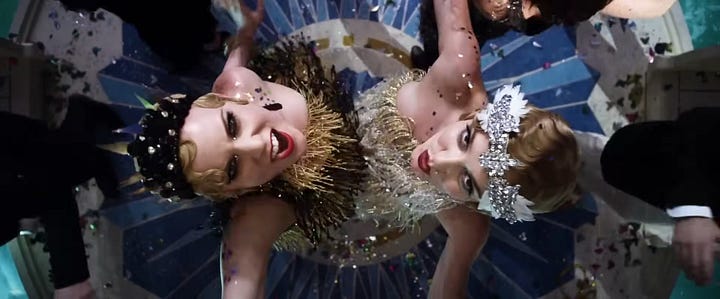From the Vault: May / June '23 Streaming
The Red Scare, A "Party in the U.S.A.," Los Angeles on Film, and Paul Newman

From May 19, 2023
Welcome" to "May" (and June) and "May (and June) streaming."
This dispatch arrives late and at a completely random time, because I've just spent a week holed up in my writers’ bungalow in Los Angeles, hunched over a typewriter like Faulkner pounding out subpar screenplays between bouts of Old Grand-Dad at Musso & Frank, lamenting the loss of my hometown and all its familiar comforts in the face of unfettered tinseltown glamor. Actually, I largely wrote this from a budget hotel room at the far end of the Sunset Strip, across from a Guitar Center, whose sole window overlooks an alleyway with an impressively rusted storage shed. Hollywood!
It's been a real whirlwind since May 1st kicked off International Workers’ Day, and with it the strike authorization by the WGA, as film and television writers in New York and LA picket and fight to force studios to reassess compensation for the streaming era and tackle the creative bogeyman of AI. In a seeming show of solidarity, SAG-AFTRA has now voted to authorize a strike for the first time in over 20 years, even before they begin negotiations on a new contract. What an exciting time to find ourselves in, during a month we usually reserve for progressive film programming (if only I made a little more progress on the film programming this month, instead of lounging poolside at the Roosevelt and pulling the ivy from the walls of Lisa Vanderpump's WeHo establishments)...and we've got several programs to tide you over through the end of June, which marks the expiration of the current SAG-AFTRA contract currently being re-negotiated. Is Hollywood going to shut down? Here's hoping! In some accidental synergy, we've got a retrospective on one of Hollywood's darkest eras for political organizing and an actor's showcase on one of our all-time dishiest activist film stars. Plus! A cinematic tour of Los Angeles and a little fête honoring the American Party Film. Consider this your formal invitation (just say "open sesame" to the owl on the bookshelf) and come on inside...it's definitely not a Essex Nashville party!
Waldorf (Word) Salad: Key Films of the Red Scare

On November 25, 1947, forty-eight American film executives convened on the Waldorf-Astoria for a closed door session, the results of which would transform Hollywood and set in motion one of the darkest chapters in American history, forever altering the lives of progressive artists and entertainers in this country. Their objective was to formulate a response to the House Un-American Activities Committee's contempt charges against the "Hollywood Ten," a group of film creatives who refused to incriminate themselves by testifying about their political beliefs before Congress, refusing to state whether they were ever members of the Communist Party. The Hollywood studio response, which came to be known as the Waldorf Statement, declared, "We will forthwith discharge or suspend without compensation those in our employ, and we will not re-employ any of the 10 until such time as he is acquitted or has purged himself of contempt and declares under oath that he is not a Communist. On the broader issue of alleged subversive and disloyal elements in Hollywood, our members are likewise prepared to take positive action. We will not knowingly employ a Communist or a member of any party or group which advocates the overthrow of the government of the United States by force or by any illegal or unconstitutional methods." With that, the Blacklist Era began, but it was just the start of the horrific cultural reckoning to come. As you're no doubt aware, American geopolitical conflict with the Soviet Union after World War II led to a culture of paranoia and fear towards all manner of progressive thought (seemingly evocative of the ideals of the Soviet Union and the egalitarian society promised under global communism) that challenged the notion that America was anything but the Greatest Country in the World: anti-racism, queer sexuality, and economic inequality were just some of the targets for the larger anticommunist hysteria, and Americans who refused to effectively prove that they were not, nor had they ever been, an agent working against the interests of the State Department found their lives and livelihoods destroyed by actual witch hunts. Thanks to a childhood obsession with Lucille Ball, who was called to testify before HUAC, I've pretty much always been preoccupied with this moment in Hollywood history and American history at large. In college, I took a course (from a self-professed "red diaper baby" and badass former archivist for SAG-AFTRA) specifically on women in the entertainment industry during the Blacklist era; my professor refused to refer to the period as the "McCarthy Era," as it's more popularly known, because Senator Joseph McCarthy, despite his association with the "Red Scare," really had nothing to do with the actions of the entertainment industry, which colluded from the very top (from the studios to the press and all the way to the creative unions) to systematically eradicate all "subversive" political thought and build a culture of paranoia in which friends were forced to "name names" and turn their friends in as suspected communists to avoid losing their livelihoods. That's why I use the term "Blacklist Era," as she did, and is why I'm so fascinated in particular at the ways in which femininity, sexual identity, and conservative gender values were regulated under the blinding glare of anticommunist sentiment. (My favorite takeaway, for example, is that firebrand rightwing author Ayn Rand gave an impassioned, extremely friendly testimony on the scourges of communism and life in the Soviet Union, only to get summarily dismissed as a witness, as the committee thought she was too ugly and unpleasant to be a good face for their cause). This program looks back at the films emblematic of the Red Scare, divided into three definitive eras: pre-Waldorf Statement (the films that would put a target on the backs of future blacklisted creatives); the "Blacklist Era" films (films that fueled anticommunist hysteria / are evocative of the full collusion with state department propaganda or are a definitive reaction to such messaging); and the collapse of the Blacklist (following the public hiring of formerly blacklisted individuals and the general cultural rejection of McCarthyism and anticommunist hysteria). It's a thorny, fascinating era, which truly did destroy (and even take) lives. I highly recommend the excellent Hollywood Blacklist series from You Must Remember This, which gets into all of the events described here, beginning with the Waldorf Statement, and provides a deep-dive on several of the films in this program. Unfortunately, the period is more relevant than ever, as the right spreads ancient chestnuts (gay people "grooming" children, communists or "socialists" infiltrating the government, and political uprising and social consciousness acting as a threat to "law and order" and the American Way are all propaganda bits straight out of the Blacklist Era)...all to stoke a moral panic that will only further their own craven political beliefs and fundraising efforts as a distraction against the collapse of America as a world
power. The ghost of the Hollywood Blacklist is often raised disingenuously today to make arguments about "cancel culture" or "wokeism" out of control, but it's a complete logical fallacy: the Blacklist Era was a very real, and very destructive system of political oppression perpetrated against creatives (and the revolutionaries that inspired them) looking to use their platform to inspire real social change. To forget or mischaracterize this time period, particularly for the demonization of political leftists at the hands of conservatives or Liberals, is only to our own detriment.
It's a Party in the USA: The Great American Rager Onscreen




Keep reading with a 7-day free trial
Subscribe to The Spread to keep reading this post and get 7 days of free access to the full post archives.



